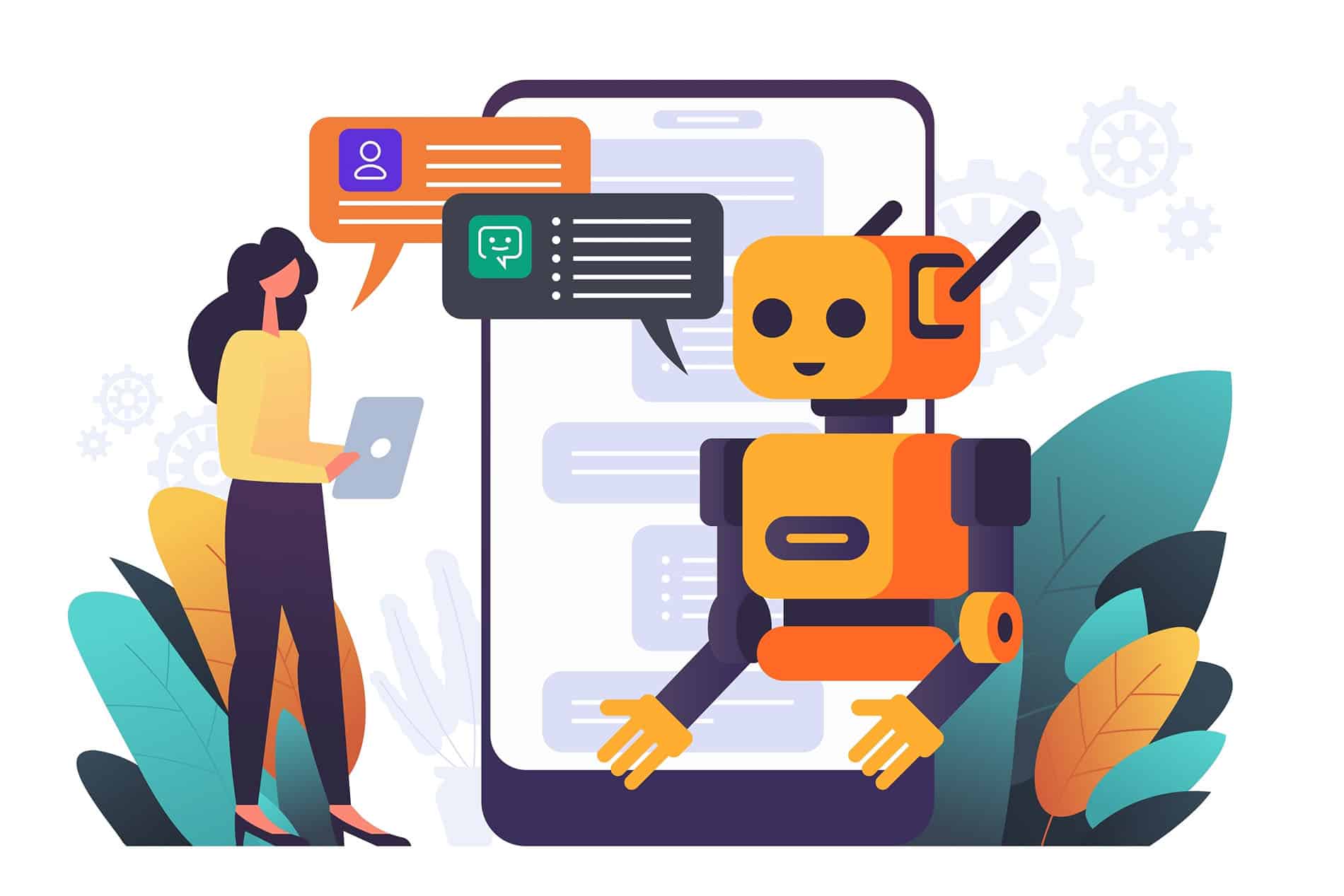Conversational AI is emerging as a new technology to enhance existing IT Service Management strategies and improve the customer experience. Conversational AI has the potential to revolutionize IT operations and customer support – enabling businesses to enhance their existing IT service offerings and empower customers with better self-service support.
In this blog, we’ll discuss the benefits of using conversational AI with your ITSM and how it can drive significant improvements in productivity, customer satisfaction, and cost savings. We’ll also take a look at the features and functionality you should invest in for success.
The Benefits of Integrating Conversational AI and ITSM
Conversational AI chatbots are intelligent software applications that can understand and respond to user queries in natural language. Their primary role in IT Service Management is to provide quick, efficient support to end-users by resolving common issues, answering questions and guiding users through various processes.
There are many benefits to using conversational AI including:
- Enhanced User Experience: Conversational AI chat offers a human-like conversational interface that makes it easy for users to interact with IT systems and seek assistance. It eliminates the need for users to navigate complex knowledge bases or submit tickets, resulting in a more intuitive and efficient experience. By offering personalized, interactive and real-time support, conversational AI chatbots can significantly enhance user satisfaction, reduce frustration and improve overall engagement.
- 24/7 Availability: Traditional IT help desks often operate within limited hours, leading to delays in issue resolution and increased downtime. However, conversational AI chatbots can be available around the clock, providing users with instant access to support and self-service options at any time. This 24/7 availability not only improves user satisfaction but also ensures prompt issue resolution, minimizing business disruptions and maximizing productivity.
- Efficient Issue Resolution: Conversational AI chat utilizes advanced natural language processing and machine learning capabilities to understand user queries and provide accurate solutions. By leveraging pre-defined knowledge bases, FAQs and historical data, conversation AI chatbots can swiftly identify and address common IT issues, providing users with quick and precise resolutions. This reduces the burden on IT support teams and frees up their time to focus on more complex tasks, resulting in faster response times and improved efficiency.
- Scalability and Consistency: As organizations grow, maintaining consistent IT service quality across various departments and locations becomes challenging. Conversational AI chatbots offer a scalable solution that ensures consistent support delivery by following predefined workflows and guidelines. It can handle multiple simultaneous conversations, catering to a large user base without compromising quality. This scalability and consistency enable organizations to meet the growing demands of their customers while keeping costs under control.
- Self-Service Empowerment: Conversational AI chatbots can play a crucial role in enabling self-service options for users. By providing an intuitive interface and access to knowledge bases, FAQs and troubleshooting guides, it empowers users to resolve common IT issues independently. In addition, with a chat solution like TeamDynamix Conversational AI, you can even take action from a conversation (like resetting a password or putting in a PTO request) without needing to talk to someone or submit a ticket. This not only reduces the dependency on IT support teams but also fosters a culture of self-sufficiency and continuous learning within the organization. Additionally, self-service options through conversational AI chatbots can significantly reduce support costs, as fewer resources are required to handle routine inquiries.
It is important to note the distinction between conversational AI chatbots and traditional chatbots.
When talking about traditional chat, we mean a chatbot experience that has a limited conversation path. It can take inputs and guided dialog paths to return answers in a simplified question/answer format – similar to what you’d get if you searched a knowledge base or FAQ – there aren’t many actions a user can take from the conversation with a traditional chatbot.
Traditional chatbots don’t fare as well as those built on conversational AI. In fact, a recent market study from CIO.com found that nearly 76 percent of chatbot customers report user frustration with existing solutions. However, When conversational AI is used, the study shows more than 61 percent of respondents could effectively resolve problems vs just 35 percent when traditional chat is used.
What to Look for When Evaluating Conversational AI Vendors
As you plan your future investments in chatbot and conversational AI technology, there are some key areas to consider and evaluate. Here’s a checklist of what to look for when selecting a conversational AI chatbot for your business or organization.
Does it have multichannel support for the following?
- Web Chat
- Teams
- Slack
- SMS/Text
- Social Media
- Web Forms
- Ticketing
When it comes to AI-Based Natural Language Processing can it handle the following?
- Intent
- Labeling
- Response Management
Are these response actions available?
- Designed Dialog Paths
- Present Knowledge Base Articles and Services
- Personalize with Data from Backend Systems
- Launch Dynamic Forms
- Send Notifications via SMS/Text, Email, or Webhook
- Live Agent Failover
- Send URLs
- Launch Automations to Fulfill Requests
- API/Webhooks
When it comes to advanced training and learning, does it include the following?
- Preloaded Training Templates
- Iterative Models
- Supervised Learning—Human-in-the-Loop
- Intent Matching Confirmation
- Exception Processing
According to a recent survey, there are four key elements for a successful chat experience when it comes to using conversational AI for self-service. The top cited element was a strong knowledge base for content to feed the chat, which was named by 75 percent of respondents. That was closely followed by the ability to personalize the conversation with details about the customer, named by 63 percent. Third and fourth place were ranked equally, named by 62 percent, who equally weighted the ability to present questions to the employee that drives dynamic content with the ability to automate the fulfillment of requests from the chat interaction.
Conversational AI especially benefits service management teams when paired with enterprise integration and automation (using iPaaS). This combination can elevate chat from a glorified knowledge base search engine into an automated, action-centered channel to field requests.
No matter how good the knowledge base, personalized user information can only be uncovered through the inherent ability to connect to business systems via APIs and integrations. This capability is what makes it possible to automatically provide dynamic content and fulfill simple, repetitive requests for action.
One example of this in action would be an employee asking the chatbot how much paid time off (PTO) they have left for the year. A first-generation chatbot may not be able to answer that, instead offering a link to the employee knowledge base article about how much PTO each employee gets annually.
A conversational AI chatbot tied to a well-connected integration and automation layer could personalize the response leveraging Single Sign-On, and then access the employee’s data from another application to deliver an accurate, fast response. In this case, the response may say, “Currently, you have 12 days of PTO left this year.” It might even follow up with a question like, “Do you want to know how many of these days will roll over next year?” or, “Would you like to request time off?” If the end-user response is to request time off, the solution would present a form for the request to be entered and then pass that data back to the PTO tracking platform.
Incorporating a conversational AI-powered chatbot as part of your ITSM strategy can significantly enhance your user experience, streamline processes and unlock cost savings. By leveraging the power of conversational AI, you can stay ahead of the curve and better deliver top-notch IT support services.
Do you want to learn more about chat vs. conversational AI? Read our newly published market study: State of Chatbots and Conversational AI.

